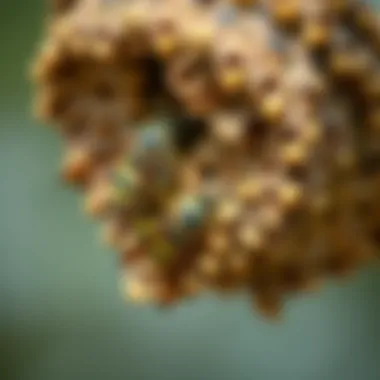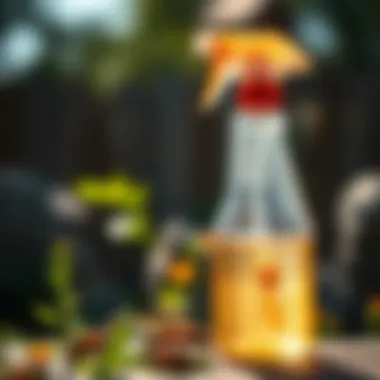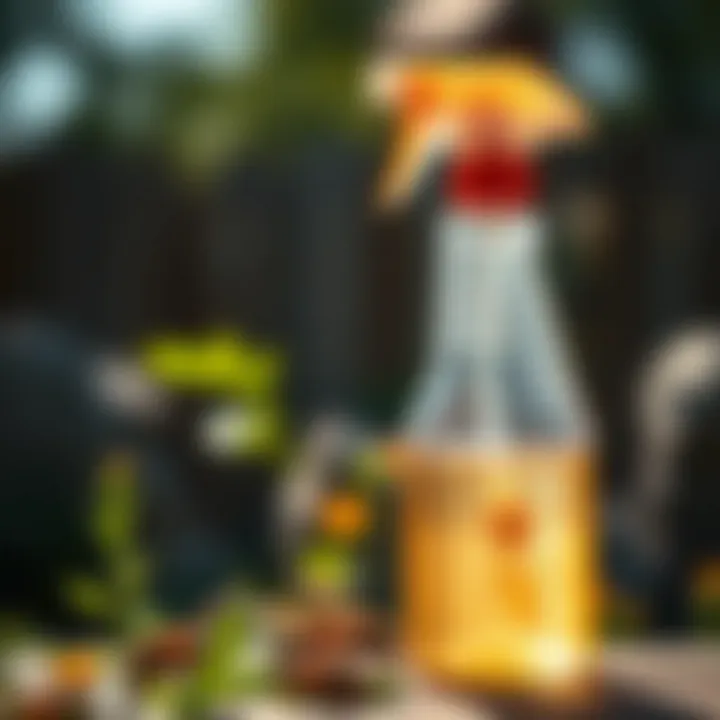Effective Ways to Get Rid of Wasps in Your Home


Intro
Dealing with wasps in the home can be a real headache. Whether you're trying to enjoy a sunny afternoon in your garden or simply walk through your living room without incident, these buzzing intruders can turn a peaceful day into a stressful situation. Understanding how to manage and ultimately eliminate wasps is crucial for maintaining a comfortable and safe environment in your home. This guide will take you through the essential aspects of wasp behavior, prevention strategies, and effective control methods.
Understanding the Pest
Identification
Before you can eliminate wasps, it’s important to know what you’re dealing with. There are several common types of wasps that might decide to share your space. The European hornet, for example, is one of the largest wasps, distinguishable by its brownish-yellow stripes. Yellow jackets are smaller and often mistaken for bees due to their coloring but possess a shinier, hairless body. Understanding what species you are dealing with can influence the method you choose for removal. If you spot a nest outside, identifying the species is critical to planning your approach.
Life Cycle
Wasps have a unique lifecycle that begins with a solitary queen, who emerges in spring to start a colony. She lays eggs, which eventually hatch into larvae. These larvae become workers and help expand the nest and gather food. As summer approaches, colonies can swell to thousands of individuals. Autumn marks the decline of the colony; the queen lays eggs that will become future queens and males, while the worker wasps die off, leaving just a few to survive the winter. Knowing this can give context to why wasps may become more of a nuisance at certain times of the year.
Pest Prevention Strategies
Environment Modification
Making your environment less hospitable to wasps is a proactive approach. Here are some practical tips:
- Seal any cracks in your home’s exterior. Wasps can squeeze through surprisingly small openings.
- Regularly clean up food and drink spills outdoors. Leaving sugary drinks or pet food unattended is an open invitation.
- Keep garbage bins tightly closed and consider using bins with tight-fitting lids to deter wasps from foraging.
Physical Barriers
Another effective strategy is to create physical barriers against wasps:
- Install window screens to prevent wasps from entering your home.
- Use mesh netting in gardens to protect flowering plants that attract wasps.
- Consider installing a wasp trap away from living areas to draw them away from your immediate surroundings.
Control Methods
Chemical Control
When prevention isn’t enough, chemical measures might be necessary. Products like wasp sprays can be effective, but caution is paramount. Always follow the manufacturer's instructions carefully. Use these sprays at dusk or dawn when wasps are least active to minimize risk of confrontation.
Biological Control
If you're looking for a less aggressive method, biological controls can work as well.
- Introducing natural predators, like certain bird species, can help keep wasp populations in check.
- You might also explore natural repellents such as peppermint oil, which is known to deter wasps when sprayed around entry points.
To maintain a wasp-free environment, regular monitoring and immediate action at the first sign of infestation are key.
For further reading and more extensive research on wasps, you can visit resources like Wikipedia or Britannica. Understanding wasps more deeply can empower you to make informed decisions in managing them effectively.
Understanding Wasp Behavior
Understanding the behavior of wasps is crucial in effectively managing and eliminating them from your home. Wasps play an important role in the ecosystem, but when their presence becomes a nuisance or a threat, knowing their habits can help in deciding the best course of action. The following aspects are essential to grasp in order to handle a wasp issue confidently:
- Behavioral Patterns: Wasps tend to be more aggressive during late summer and fall, as their natural food sources dwindle. Knowing this can prepare homeowners for potential encounters.
- Territory Establishment: Understanding that wasps are territorial creatures means that they defend their nests vigorously. This awareness is critical when considering removal tactics and safety measures.
- Social Structure: Wasps live in colonies, with a queen, workers, and drones, each with distinct roles. Recognizing this hierarchy helps in understanding the impacts of nest removal on the colony.
By grasping these elements, individuals are better equipped to manage wasp-related situations in a calm and collected manner.
Types of Wasps Commonly Found in Homes
Several species of wasps may take up residence around homes, each with unique behaviors and nesting preferences:


- Yellowjackets: Easily recognized by their distinctive black and yellow coloration, yellowjackets are known for their aggressive behavior, especially when they feel threatened. They often build nests in wall cavities or underground.
- Paper Wasps: These wasps create umbrella-shaped nests that are often found hanging in eaves or tree branches. They tend to be less aggressive but can still sting if provoked.
- Bald-Faced Hornets: A type of yellowjackets, bald-faced hornets are larger and also build aerial nests resembling large, gray papery balls. They will defend their nests fervently, so caution is key when near them.
Familiarity with these wasps can aid in identifying them when spotted around your home.
Wasp Habits and Life Cycle
Understanding the life cycle of a wasp provides insight into their population dynamics. Wasps typically go through four stages: egg, larva, pupa, and adult. Here are some notable points:
- Spring Development: In early spring, a fertilized queen emerges from hibernation and starts a new colony, laying eggs that develop into workers who help expand the nest.
- Summer Growth: As the season progresses, colonies reach their peak. More workers are present, and food sources become limited, leading to increased aggression as they seek alternatives to their natural diet.
- Fall Decline: When colder weather approaches, most workers die off leaving only new queens to survive through winter, while the colony dwindles.
Awareness of their cycle can inform proactive measures, particularly before they reach numbers that can become problematic.
Identifying Wasp Nests
Spotting a wasp nest is key to effective control measures. Here are a few tips to identify them:
- Location: Look for nests in sheltered areas such as eaves, attics, or hidden spots around your yard. Yellowjackets often build nests underground or in abandoned rodent burrows.
- Size and Appearance: A typical wasp nest can vary; yellowjackets tend to build larger nests than paper wasps. They are often gray or brown in color and have a paper-like texture.
- Activity Observation: Noticing increased wasp activity around a specific area, particularly in late summer, often indicates the presence of a nest nearby. Watching their flight path can also help in locating it.
Identifying wasp nests promptly is a vital step in managing an infestation effectively.
Assessing the Severity of the Infestation
Before taking any action against wasps in and around your home, it’s paramount to assess the severity of the infestation. This crucial step ensures that homeowners can determine the best course of action. Misjudging the situation could lead to unnecessary expenses, or worse, exacerbate the problem. Understanding how many wasps you’re dealing with and their nesting habits provides insight into the most suitable control methods.
Identify the type of wasps involved; some species, like the yellow jackets, can be particularly aggressive. Assessing whether you have a few stragglers or a robust population is key. There’s a huge difference between a solitary wasp sporadically buzzing around versus a full-blown nest teeming with activity.
Signs of Wasp Presence
Monitoring and detecting signs of wasps can be the difference between early intervention and a full-blown invasion. Here are key indicators:
- Frequent Sighting: If you notice wasps consistently around your property, especially near food sources, it suggests a nearby nest.
- Aggressive Behavior: Wasps tend to get more aggressive when they feel threatened. If they seem particularly defensive around certain areas, take notice.
- Visible Nests: Check for any nests, which resemble a paper-like structure, often situated in sheltered areas like eaves, attics, or even tree branches.
"An ounce of prevention is worth a pound of cure." Keeping an eye out for these signs means tackling wasps while they’re still a manageable nuisance.
- Chirping Sounds: It might sound strange, but if you hear persistent buzzing, especially near potential nesting sites, that’s a telltale sign.
- Lost Food and Garbage: Wasps are drawn to sweet and protein-rich foods. If you find them hanging around trash bins or picnic areas, they’re likely scouting for food sources.
Knowing these signs empowers homeowners to act quickly, mitigating potential hazards before they escalate.
Determining the Nest Location
Finding the nest location is a pivotal component of assessing wasp infestation severity. Understanding where these pests are nesting can guide homeowners to select the right removal strategy. Here’s how to pinpoint the nests effectively:
- Follow Their Flight Path: Watch where the wasps fly to and from. They usually have a direct path to their nest, which can often lead you right to it.
- Time Your Search: Early morning or late evening is the best time to search. Wasps are less active during these times, so you can observe their movements more safely.
- Inspect Hiding Spots: Common nesting areas include:
- Look for Structural Damages: Pay attention to signs of damage or droppings near potential nesting areas. This can often indicate that residents have set up shop.
- Use a Flashlight: At dusk or before dawn, with less risk of agitation, shine a flashlight around suspected areas to catch a glimpse of the nests.
- Under roof eaves
- Inside wall cavities
- Hollow trees
- Garden sheds and garages
Determining where the wasps call home is vital for both safety and effective action. Once you know the nest's location, you can make an informed decision on whether DIY removal is feasible or if it’s best to call in professionals.
As daunting as it may seem, taking these careful steps leads to a more controlled and strategic approach towards addressing wasp problems in your home.
Safety Precautions Before Removal
Before embarking on the journey to eliminate wasps from your home, understanding the importance of safety precautions is paramount. Wasps don't take kindly to threats, and a careless approach can lead to painful stings or even allergic reactions. By prioritizing safety, you’re not only protecting yourself but also ensuring the removal process is as smooth and effective as possible. Here’s what you need to know.
Protective Clothing


Wearing appropriate protective clothing is crucial when dealing with wasps. A standard outfit might not cut it; you should think like a bee keeper, without the intention to keep them, of course! Here’s a checklist for attire:
- Long Sleeves and Pants: Opt for thick, protective fabrics that cover your skin completely. This can minimize the chances of getting stung.
- Gloves: Wear gloves to shield your hands, which are often vulnerable during removal tasks.
- Face Protection: A hat with a wide brim or a veil can protect your face, particularly your eyes and ears, which are sensitive areas.
- Sturdy Footwear: Shoes should be closed and sturdy; sandals won’t do. This is not the time to risk stubbed toes or more serious injuries.
Ensure that your clothing is light-colored, as wasps are attracted to darker shades. Tight-fitting clothes can also help by preventing entry points for curious wasps. The goal here is to put as much distance between them and your skin.
Emergency Procedures for Stings
Even with all precautions in place, the risk of being stung is present. It’s vital to get familiar with a few emergency procedures. Knowing how to react swiftly can make all the difference. Here’s a handy guide:
- Stay Calm: If a wasp stings you, try to remain calm. Panic can amplify your body's reactions.
- Remove the Stinger: If the insect left its stinger in your skin, scrape it out gently with a flat object, like a credit card—or even the back of your fingernail. Avoid using tweezers as pulling could release more venom.
- Clean the Area: Wash the sting site with soap and water to reduce the chance of infection.
- Ice the Affected Area: Applying ice or a cold compress can help ease pain and reduce swelling.
- Monitor for Allergic Reactions: Keep an eye on symptoms. If you experience dizziness, swelling in the throat, or difficulty breathing, seek emergency care immediately.
Always err on the side of caution when dealing with wasps. Having a plan in place for removal, as well as a response plan for stings, can make a significant difference in your safety and effectiveness.
By being methodical and taking these safety measures to heart, you can approach wasp removal with confidence and care, ensuring a safe and effective operation. Preparing for the unexpected makes a tough job a bit more manageable.
DIY Wasp Control Methods
When it comes to managing pesky wasps that invade our personal space, DIY methods can be a practical and effective tool in your arsenal. The charm of these approaches lies in their simplicity, affordability, and the satisfaction that comes from handling the situation yourself. By utilizing DIY wasp control methods, you not only save on the cost of professional pest control but also gain a greater understanding of your environment and how to manage it.
Effective DIY solutions aim to repel or trap wasps without using harsh chemicals that could affect your family or pets. It’s especially essential for householders, as safety and effectiveness must go hand in hand. Exploring different methods allows you to experiment and discover what works best in your unique situation, effectively putting the reins back in your hands.
Traps and Baiting Techniques
Traps are a popular choice for homeowners seeking a straightforward and often passive approach to wasp control. Using bait lures wasps with irresistible scents, making it easier to catch them without needing to engage in direct confrontation. One of the simplest techniques involves creating your own trap using a plastic bottle. Cut the bottle in half, and invert the top half into the bottom, securing it with tape. Fill it with a sweet mixture, like sugar water or soda, to entice these pests inside.
However, it's crucial to place traps away from areas where people frequent, as the last thing anyone wants is a swarm of angry wasps closer than they should be. Furthermore, regularly check and empty the traps to ensure they remain effective. A consistent routine will keep the numbers down and prevent further nesting near your home.
Natural Repellents
Natural repellents are another avenue to explore when addressing a wasp problem, providing an eco-friendly alternative to traditional chemical sprays. These solutions leverage common household items, allowing for accessibility and minor environmental impact.
Vinegar Solutions
A standout option in this category is vinegar solutions. By mixing equal parts water and vinegar, you create a potent liquid that repels wasps. The sharp scent of vinegar is not something wasps fancy, which makes it an effective barrier when sprayed around entry points to your home. Additionally, this method has the benefit of being entirely safe for humans and pets, unlike harsh chemicals, making it an appealing choice for many families.
However, it's vital to understand that while vinegar can deter wasps, it may need to be reapplied on a regular basis, especially after rain or significant weather changes. But in the long run, the low cost and safety features of vinegar make it a beneficial option in your DIY pest control strategy.
Essential Oils
Essential oils have gained popularity not only for their relaxing properties but also for their pest-repelling qualities. Oils like peppermint, cedarwood, and clove are known for their ability to naturally deter wasps. Simply mix a few drops of essential oil with water in a spray bottle, and use it around problematic areas. The nice thing about essential oils is their pleasant fragrance, offering a sense of comfort rather than the sharp aroma of traditional repellents.
Nonetheless, remember that like vinegar, essential oils demand regular application to remain effective. This is due to their susceptible nature, which can decrease when exposed to sunlight or wind. Despite the potential drawbacks, their natural origin and pleasant scent solidify their position as powerful allies in wasp control.
Physical Barriers
Lastly, physical barriers present a more hands-on way of dealing with wasps. This straightforward method emphasizes prevention and can be remarkably effective. By physically blocking access points, you can deter wasps from entering your home. Screen doors, sealed windows, and well-fitted vents help in creating an unwelcoming environment for these insects. Taking the time to inspect for gaps or holes, particularly in your house foundation or attic, will also pay off.
Utilizing these DIY control methods provides households with practical and sustainable solutions for wasp management. Adapting various techniques can help you sculpt the best approach suited to your living space, leading to a safer, more comfortable environment.
Professional Treatment Options
Dealing with wasps can be quite the headache, especially when they decide to make your home their own. While many homeowners attempt DIY methods to tackle an infestation, it’s essential to recognize when it’s time to enlist the help of professionals. This section dives into why professional treatments are not just a luxury, but a necessity in certain circumstances.
When to Call Experts


Determining the right moment to contact a pest control service is crucial. Here are some clear signs indicating that professional help is warranted:
- Significant Nest Size: If the nest is larger than a golf ball, it’s best to let the experts handle it. A larger nest often means a more significant number of wasps, increasing the risk of attacks.
- Multiple Nests: Finding several nests around your home can spell trouble. DIY methods might only address one, leaving the others to thrive.
- Allergy Concerns: Households with members who have severe allergies to insect stings should never attempt removal themselves. Even a single sting can lead to serious health complications.
- Persistent Infestation: If wasps keep returning despite your best efforts, it’s time to call in the professionals who can provide a thorough assessment.
Recognizing these indicators will spare you unnecessary risks and yield more effective results.
Chemical Treatments
Professional pest control services often utilize specialized chemical treatments that are highly effective against wasps. These substances are typically more potent than over-the-counter options, providing a quicker solution to eliminate the threat. Here's a detailed look at why these treatments are beneficial:
- Targeted Formulations: Experts have access to commercial-grade insecticides that target wasps specifically, reducing collateral damage to other beneficial insects.
- Strategic Application: Professionals know precisely where and how to apply these chemicals, greatly minimizing the risk of exposure to humans and pets.
- Residual Effectiveness: Many of these chemicals continue to work after application, ensuring any returning wasps are dealt with promptly.
- Ensuring Safety: Trained technicians follow safety protocols during application. They provide you with peace of mind, knowing your home is treated with the utmost care.
Eco-Friendly Professional Solutions
As more people grow environmentally conscious, the demand for eco-friendly pest control solutions has seen a marked increase. Pest control companies now offer several green options that prioritize safety while effectively managing wasp populations. These methods may include:
- Biological Pest Control: Some professionals introduce natural predators into an environment, allowing nature to take its course.
- Botanical Insecticides: Derived from plants, these insecticides are less harmful to the environment and can be quite effective.
- Integrated Pest Management (IPM): This approach involves combining multiple strategies while minimizing chemical usage. It’s aimed at preventing wasp issues over the long term through methods such as habitat modification or exclusion techniques.
Employing eco-friendly solutions not only manages wasp populations effectively but aligns with sustainable living practices that many homeowners value.
"Choosing the right pest control method can greatly influence the health of your home environment and community."
Post-Removal Strategies
Taking action against a wasp infestation is no small feat, but the responsibility doesn't end just with their removal. The post-removal strategies play a crucial role in ensuring your home remains a wasp-free sanctuary. Ignoring these strategies could mean that before you know it, those pesky intruders make a comeback. Let’s dive into the steps you need to take to fortify your fortress against future infestations.
Sealing Entry Points
One of the first lines of defense against wasps is addressing the entry points into your home. Wasps are surprisingly resourceful, and they can squeeze through the tiniest of gaps. Here’s how to make your space tighter than a drum:
- Inspect for Gaps: Closely examine window frames, doors, eaves, and any other areas where outside meets inside. Even gaps as small as a pencil eraser can serve as an invitation for these critters.
- Filling and Covering: Use caulking to seal these gaps. For larger openings, consider expanding foam or wire mesh. These materials can block wasps while still allowing air circulation.
- Maintenance of Screens: Make sure window and door screens are in good repair. A torn screen is basically rolling out the carpet for unwanted guests. Keep them tight and secure.
By closing off entry points, you significantly lessen the chances of wasps setting up shop in your home again. It's all about preparation and being proactive.
Ongoing Monitoring and Maintenance
Even after your thorough clean-up, remain vigilant. Ongoing monitoring and maintenance can mean the difference between a peaceful home and another pesky infestation. Here are steps to keep wasps at bay:
- Regular Inspections: Keep an eye on the exterior of your home. Walk around your property to look for any new nests forming. Early detection is often the key to preventing problems.
- Seasonal Clean-ups: As the seasons shift, ensure to clear away any debris, especially in late summer or early fall, when wasps are most aggressive in searching for food and shelter. Remove fallen branches, decaying fruit, or anything else that might attract them.
- Educating Yourself and Others: Share your newfound knowledge with household members. Understanding wasp behavior can generate a sense of alertness that’s beneficial for everyone involved.
Staying on top of these strategies is like locking the door after the lock has been replaced. It creates a robust barrier against the return of an unwanted invasion, allowing you to breathe easy in your own space.
"An ounce of prevention is worth a pound of cure." It’s always better to take simple precautionary measures than to deal with a full-blown infestation again.
Coping with Wasp Stings
Dealing with wasps can be a real headache, especially when it comes to the inevitable risk of being stung. Understanding how to cope with wasp stings is critical for every homeowner, as it can not only alleviate pain but also prevent complications. Not everyone reacts the same way to stings; therefore, knowing what to do and when to seek help can make a world of difference in managing these uncomfortable encounters.
First Aid Steps
If you find yourself on the wrong end of a wasp sting, here's a straightforward guide to follow:
- Stay Calm: It’s easier said than done, but remaining calm helps to slow down your heart rate, which may reduce the spread of venom.
- Remove the Stinger: Unlike bees, wasps can sting multiple times. If there’s a stinger left behind, remove it gently with a pair of tweezers or your fingers, taking care not to squeeze it further.
- Clean the Area: Use soap and water to wash the sting site. This helps avoid infection and reduces irritation.
- Apply a Cold Compress: Place a cloth with ice or a cold pack on the sting site for about 10 to 15 minutes. This helps to reduce swelling and numbs pain.
- Use Over-the-Counter Pain Relief: If the pain is significant, consider taking an over-the-counter pain reliever like ibuprofen or acetaminophen.
- Topical Treatment: Anti-itch creams or hydrocortisone cream can help alleviate itching and discomfort at the site of the sting.
Recognizing Allergic Reactions
While many people experience mild reactions to wasp stings, some can have severe allergic reactions, which are medical emergencies. Be vigilant for the following symptoms:
- Widespread Rash or Hives: A severe rash that spreads beyond the sting site could indicate an allergic reaction.
- Swelling Beyond the Sting Site: If swelling extends to the face, lips, or throat, it’s a warning sign.
- Difficulty Breathing: Wheezing or an inability to catch your breath is serious and requires immediate medical attention.
- Rapid Heart Rate or Dizziness: These symptoms may point to shock, a critical condition needing emergency help.
- Nausea or Vomiting: Feeling nauseated or vomiting after a sting could also be an indication of an allergic reaction.
Understanding these first aid steps and recognizing allergic reactions can provide reassurance and preparedness for handling wasp stings effectively. This knowledge not only empowers homeowners but also contributes to the overall safety of your living space. For more detailed guidelines, consider visiting health-related resources like Mayo Clinic or WebMD.







